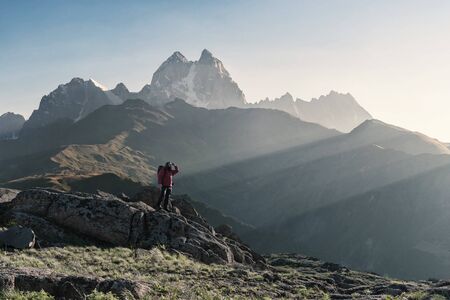Introduction: Navigating the Maze of British Trails
In the heart of Britain’s wildest landscapes, navigation isn’t just a skill—it’s your lifeline. Picture yourself battling the whipping winds atop a Lake District fell, or picking your way through mist-shrouded Dartmoor, where every tussock and tor stirs with legends. Whether you’re conquering the craggy summits of Snowdonia or braving the rain-lashed ridges of Scotland’s Highlands, knowing exactly where you are can be the difference between an epic day out and a story best left untold. For UK hikers, navigation is an art forged by centuries of ramblers, climbers, and explorers who trust their lives to maps and compasses—or now, perhaps, to digital screens aglow in the gloom. The question for today’s adventurer: do you put your faith in the time-honoured Ordnance Survey paper map, with its intricate symbology and unmistakable British charm? Or do you stride into the future with GPS-powered digital mapping tools that promise precision at your fingertips? As we delve into this ultimate comparison, prepare to uncover which navigation method will see you safely across bogs, over summits, and back to the warmth of a country pub.
2. The Classic Charm of Ordnance Survey Maps
If you’ve ever tramped the windswept ridges of Snowdonia or braved the boggy wilds of Dartmoor, chances are you’ve unfurled a classic Ordnance Survey (OS) map. These paper legends have shaped generations of British adventurers, earning their place as a national treasure. There’s an undeniable romance in cracking open that crisp fold, running your fingers over the textured surface, and breathing in the faint scent of ink and possibility.
British Heritage: More Than Just Cartography
The OS map is steeped in British history—its roots stretching back to the 18th century when surveyors mapped the land for military defence. Today, those iconic pink and orange covers signal reliability and adventure, whether you’re tackling the Pennine Way or navigating the Lake District’s maze of fells.
Tactile Experience and Ritual
There’s grit in plotting your route by hand. Lay out your map on a pub table, pint at hand, compass ready. Each contour line becomes a promise of challenge; every symbol is a secret waiting to be unlocked. The act of planning—measuring distances with your finger, tracing rights of way—transforms navigation into a rewarding ritual unmatched by digital convenience.
Accuracy and Detail: Why OS Maps Still Matter
| Feature | Ordnance Survey Maps | Digital Tools |
|---|---|---|
| Topographic Detail | Highly detailed contours, footpaths, boundaries | Variable; depends on app and zoom level |
| Reliability | No battery needed; always works in any weather | Dependent on device charge and signal |
| Cultural Context | Local names, listed landmarks, historical sites included | May lack local nuance or traditional naming |
| Tactile Planning Experience | Physical engagement with route plotting | Mainly screen-based interaction |
The Verdict on Tradition
Pound for pound, nothing beats the immersion of a proper OS map session. You’re not just charting coordinates—you’re connecting with centuries of British exploration. For UK hikers craving authenticity and hands-on adventure, the humble paper map remains an indispensable ally.

3. Digital Mapping Tools: Tech on the Tors
When you’re standing atop a blustery Dartmoor tor, with rain lashing sideways and visibility dropping to nil, nothing feels more futuristic—or frankly, more reassuring—than whipping out a smartphone loaded with the latest mapping app. The rise of digital navigation has been nothing short of revolutionary for UK hikers. GPS-enabled smartphones, dedicated devices, and apps like OS Maps, ViewRanger, and Komoot have transformed how we plot our routes and react to the wild unpredictability of British terrain.
The Gadget Revolution Hits the Trails
The modern hiker’s toolkit now includes pocket-sized technology that would make Shackleton green with envy. Smartphones equipped with high-resolution touchscreens can pinpoint your location within metres on an interactive map overlay, even as you trudge across Yorkshire moorland blanketed in fog. With downloadable maps for offline use—a godsend in remote Welsh valleys where signal drops faster than your energy—digital tools have become indispensable companions.
Real-World Reliability: From Mist to Crags
British hiking conditions are notorious for shifting from benign to brutal in minutes. Digital mapping apps excel in these moments: not only can you confirm your bearings when the path dissolves into a bracken-choked hollow, but you can instantly re-route if swollen rivers or landslips block your way. Apps like ViewRanger offer augmented reality features; simply hold up your phone and scan the horizon, and peak names pop up—no squinting at distant trig points required.
Battery Life vs Battery Hen Weather
Still, even the best tech isn’t invincible against the UK’s legendary elements. Torrential rain on a Scottish Munro or salt spray along Cornish cliffs can reduce touchscreens to unresponsive slabs of glass. Battery life is another Achilles’ heel; sub-zero temperatures on a Lake District fell drain charge fast. Savvy adventurers carry power banks or revert to paper maps as backup—because nothing says ‘adventure’ quite like coaxing a dying device back to life beneath a bothy roof.
For all their wizardry, digital tools demand respect: they reward preparation and punish complacency. But used wisely, they open up Britain’s wildest places with confidence that borders on audacity—turning every hike into an epic worthy of legend.
4. Head-to-Head: Field Testing in True British Weather
If you’re braving the wilds of Snowdonia or embarking on a soggy trudge along the Pennine Way, you know full well that “unpredictable” barely scratches the surface of British weather. Here’s where we separate the wheat from the chaff: a no-nonsense, boots-on-the-ground comparison between Ordnance Survey (OS) paper maps and digital mapping tools—tested in relentless rain, gale-force winds, and pea-souper fog.
Paper Maps vs Digital Devices: The Gritty Reality
| OS Paper Maps | Digital Mapping Tools | |
|---|---|---|
| Rain Resistance | Waterproofed if laminated; otherwise, expect crumpling and ink smudges after a downpour. | Dependent on device case quality; touchscreens often falter when wet. |
| Wind Endurance | Prone to flapping away or tearing unless securely folded; requires both hands in gusty conditions. | One-handed operation possible, but risk of dropping device increases with wind chill and numb fingers. |
| Fog Navigation | No location pinpointing—navigation relies on compass skills and dead reckoning. | GPS shows real-time location but can lag or lose signal in deep valleys or thick woodland. |
| Battery Life/Power Source | No batteries required—reliably old-school for multi-day treks. | Batteries may drain rapidly due to cold; power banks add extra weight, but are essential for longer trips. |
| User Experience in Harsh Conditions | Tactile and readable under most lighting; challenging to handle with gloves. | Backlit screens useful in low light; fiddly with gloves, and touchscreens can be temperamental when damp. |
A Real-World Test: Pennine Way Challenge
Trekking the full length of the Pennine Way offers a brutal proving ground for both tools. After four days of squalls and mist, OS paper maps—protected by a rugged map case—still offered unfailing reliability. Meanwhile, digital mapping apps delivered pinpoint accuracy until battery anxiety set in around day three. Charging at remote bothies? Not always an option.
The Verdict?
If your adventure takes you into the teeth of Britain’s wildest weather for days on end, OS paper maps remain an unyielding ally—so long as you keep them dry and your navigation skills sharp. Digital mapping tools shine for quick checks and easy route planning, but only if you’ve got enough juice to last till journey’s end. When push comes to shove, many seasoned UK hikers pack both—a true belt-and-braces approach for whatever the elements throw their way.
5. Local Knowledge and Cultural Connections
When it comes to exploring the British countryside, navigation is far more than simply following a line from A to B. Both Ordnance Survey (OS) maps and digital mapping tools offer unique ways to immerse yourself in the living history, folklore, and community spirit that define walking in the UK.
The OS Map: A Portal to Tradition
Unfolding a classic paper OS map is like unlocking a secret language of the landscape. Every contour, field boundary, and shaded woodland tells a story passed down through generations of ramblers. These maps don’t just chart terrain—they reveal ancient footpaths, bridleways, and rights of way, many of which have been trodden for centuries. Spotting symbols for historic churches, stone circles, or even a humble village green can spark impromptu detours steeped in local legend.
In Tune with the Land
There’s an unmatched satisfaction in matching a faded fingerpost or dry-stone wall with its cartographic counterpart. OS maps often include names for woods, farms, and streams that rarely appear on digital tools—inviting you to connect with the land as locals have done for decades. And when you find yourself at a crossroads marked only by a weathered signpost, you’re not just navigating—you’re participating in Britain’s storied walking tradition.
Digital Tools: Instant Access, Modern Connections
Digital mapping apps bring their own magic to the table. Real-time location tracking offers reassurance when mist descends over the fells or the moors swallow up familiar landmarks. Many apps also crowdsource trail reviews and updates—meaning local knowledge is never more than a swipe away. If a path is muddy after rain or a stile has seen better days, chances are someone’s flagged it online already.
Blending History and Community
Some platforms overlay routes with heritage sites or recommend classic pub stops along your way—because no British hike is complete without a pint by the fire or a cheeky packet of crisps at the village local. Digital tools can also alert you to guided walks, events, or conservation efforts happening nearby, helping you become part of the ongoing story of Britain’s great outdoors.
Tradition Meets Technology
Ultimately, whether you’re deciphering an OS map under an ancient oak or checking your phone beneath Victorian railway arches, both methods root you firmly in Britain’s unique walking culture. The real adventure lies in how these tools connect us—not just to place, but to people and traditions that make every hike across the UK something truly unforgettable.
6. Which Should You Carry? The Adventurer’s Verdict
It’s decision time, and there’s no room for dithering on windswept ridges or in the depths of Dartmoor fog. Let’s get straight to the brass tacks: paper Ordnance Survey maps and digital mapping tools each have their champions—and their fatal flaws.
The Pros and Cons: Old-School vs Tech
Ordnance Survey Paper Maps
- Pros: Bombproof reliability—no battery, no signal, no worries. Huge coverage at a glance, perfect for last-minute route changes when you’re caught in a bog or fancy a detour to the nearest pub.
- Cons: Vulnerable to rain (unless you’re savvy with map cases), awkward in howling gales, and can be bulky if you’re tackling multi-day epics.
Digital Mapping Tools
- Pros: Pinpoint GPS accuracy, dynamic route planning, instant re-routing if you’ve wandered off-piste. Access to up-to-date terrain data and emergency location sharing—a real lifeline when things go pear-shaped.
- Cons: Battery anxiety is real, tech can fail at the worst moment, and reliance on screens dulls your natural navigation instincts. Also, signal blackspots are still a thing in Britain’s wildest corners.
The Hybrid Tactic: The Modern Rambler’s Secret Weapon
The ultimate weapon in the UK hiker’s arsenal? Combine both. Use digital tools for planning and navigation on the move, but never hit the hills without a trusty OS map tucked into your pack as backup. Practise your analogue skills; don’t let them fade. If your phone dies mid-blizzard or you’re battered by Highland squalls, that humble sheet of paper could be your ticket home.
The Bold Advice
If you want to thrive—nay, conquer—the British outdoors, embrace both worlds. Tech makes you nimble; tradition keeps you safe. Always carry a waterproofed OS map and compass alongside your favourite app or GPS device. Learn to read the land as well as the screen. Because out here, it’s not just about survival—it’s about adventure, resilience, and having legendary stories to tell over a pint back at the local.


